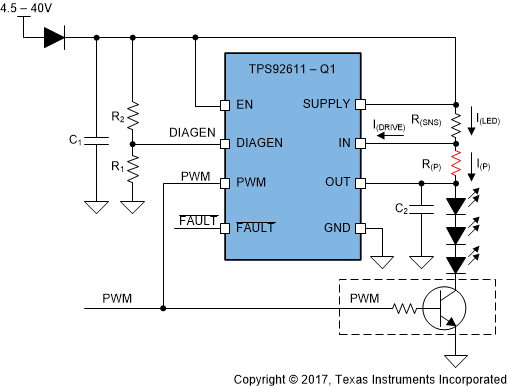SLDS238B January 2018 – January 2020 TPS92611-Q1
PRODUCTION DATA.
- 1 Features
- 2 Applications
- 3 Description
- 4 Revision History
- 5 Pin Configuration and Functions
- 6 Specifications
- 7 Detailed Description
- 8 Application and Implementation
- 9 Power Supply Recommendations
- 10Layout
- 11Device and Documentation Support
- 12Mechanical, Packaging, and Orderable Information
Package Options
Mechanical Data (Package|Pins)
- DGN|8
Thermal pad, mechanical data (Package|Pins)
- DGN|8
Orderable Information
8.2.2 Single-Channel LED Driver With Heat Sharing
Using parallel resistors, thermal performance can be improved by balancing current between the TPS92611-Q1 device and the external resistors as follows. As the current-sense resistor controls the total LED string current, the LED string current I(LED) is set by V(CS_REG) / R(SNS), while the TPS92611-Q1 current I(DRIVE) and parallel resistor current I(P) combine to the total current. Note that the device is not able to control the parallel resistor path, thus TI does not suggest to use one-fails–all-fail with this topology. For PWM applications, TI suggests to add an external bipolar switch at the bottom of LED strings. The PWM input and bipolar switch inputs must be tied together to minimize delay mismatch and to avoid false open-circuit faults.
